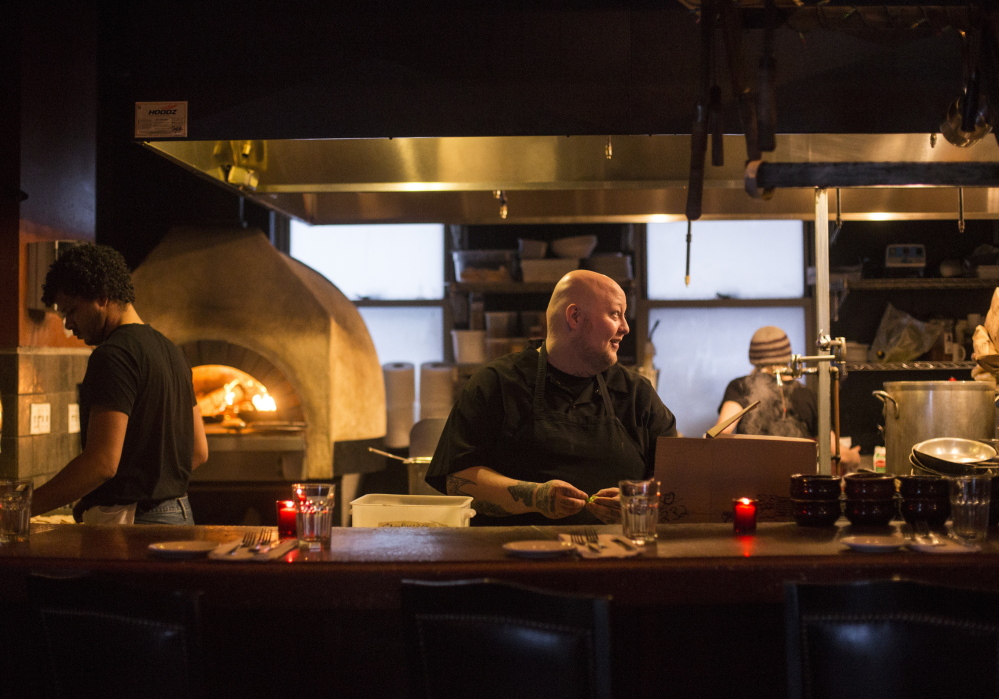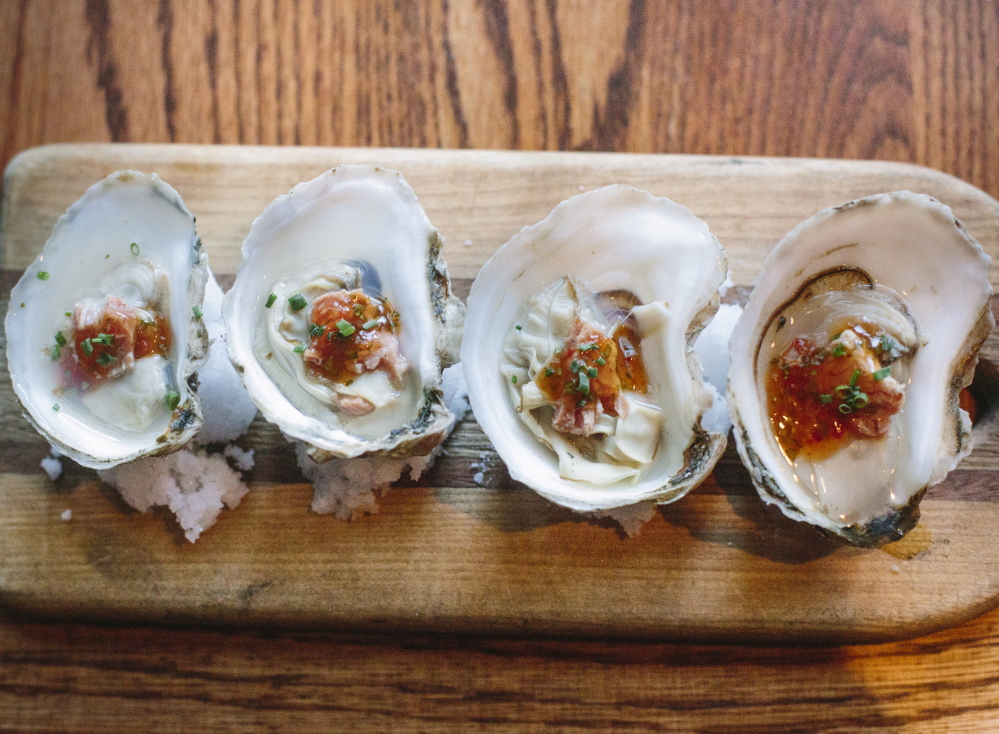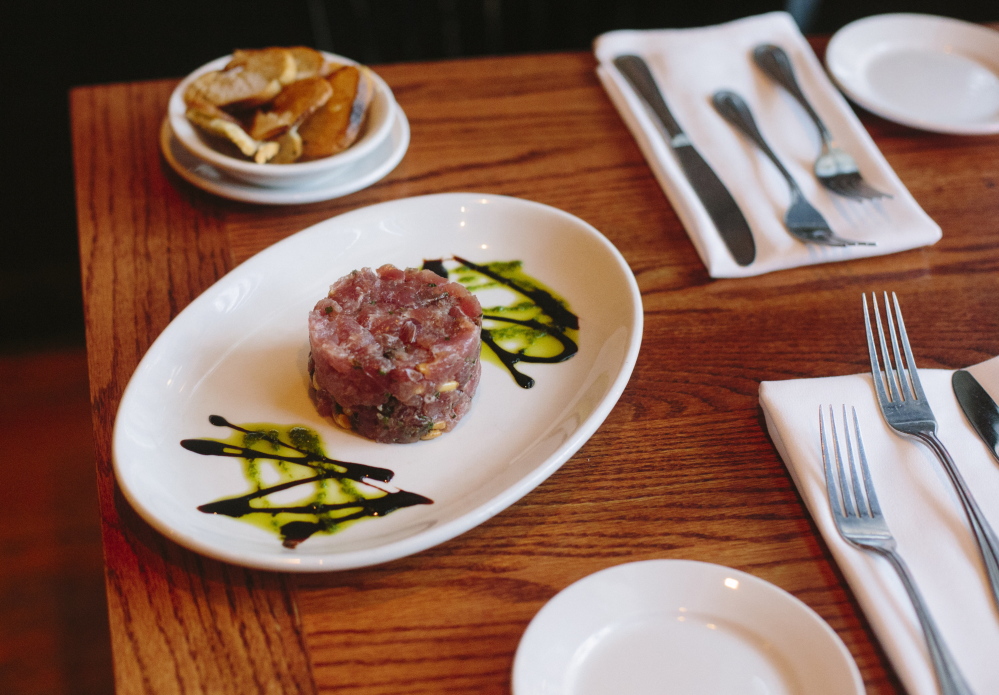A few suggestions before you head to The Grill Room & Bar on Exchange Street in Portland.
First, go hungry. Portion sizes at this self-described “urban steakhouse” are ample to the point of extravagant; even if you order a sirloin described as “petite,” you’re likely to walk back to your car groaning or swearing to skip breakfast the next day.
Second, go with a group. This is a busy, noisy, crowded downtown restaurant with a decidedly casual vibe, and since you can’t beat the crowd filling the place, you may as well join ’em. (Another good reason to go with friends: The tables set aside for solo diners and couples are cramped and squeezed into high-traffic areas where you’re likely to feel vulnerable to staff rushing by. Larger tables and booths are much more comfortable.)
Third, listen up. Waiters and waitresses here point out information you might otherwise miss, from specifics about how entrées are prepared (medium-rare steaks are served cool in the center, for example, unless you make a point of asking for something different) to the list of specials that supplement the daily menu. And finally, save room for dessert. But more about that later.
A tuna tartare appetizer special ($14) offered the first hint about serving size at The Grill Room. An immense mound of Hawaiian yellow fin, the tartare was simply flavored with a few capers and chives plus lemon juice and olive oil, and appeared with matchsticks of crunchy daikon radish on top. It was a cool, light starter, and definitely large enough for two. The thin toasts served with it were good for snacking, but proved too thin to support a spoonful of tuna. Slices of house-made focaccia (baked up the street at The Corner Room, a sister restaurant) made for a sturdier base.
A plate of fried clams ($12) from Mill Cove in Boothbay was almost as generous. The clams themselves were small and sweet with succulent fat bellies filled with juice and flavor. They were tasty on their own – crispy and salty with no hint of grease – but even better after a dip into the pool of tartar sauce painted onto the plate. (One suggestion for the busy kitchen: Our order of clams arrived at the table on a cold plate. We enjoyed them warm. I’m sure we’d have liked them even more steaming hot.)
There’s a lot going on in front of the stoves at The Grill Room, and if you’re seated nearby you’ll develop a sense of appreciation for the controlled chaos on display. Last week, three young cooks were sautéing and saucing and plating and garnishing, and a fourth was barely visible behind a dense cloud of wood smoke at the grill. (The powerful hood above the flames ensures that neither you nor your clothing will head home smoky.) Entrées cooked over oak and birch include at least five cuts of beef plus fish, shellfish and poultry.
“When I came back to Portland after studying at the Culinary Institute of America in California, there were no real steakhouses here anymore … That was a niche for me,” chef/owner Harding Lee Smith said. “I thought, ‘Why not create a classic steakhouse, use as much local beef as we can find and cook it over a wood fire?’ ”
He opened The Grill Room in 2008. (Today it’s part of a four-restaurant consortium along with The Front Room, The Corner Room and Boone’s Fish & Oyster Room.) Smith says he restored the original coffered ceiling and revived the once-divided space to recall “a popular local restaurant that used to stand right across the street – F. Parker Reidy’s – a place with brick walls, stained glass, martinis – and steak.”
The menu today is heavy on steakhouse staples, from caesar and wedge salads to baked, mashed and fried potatoes; creamed spinach enriched with a truffled bechamel; and sirloin, filet, hanger, skirt, ribeye steaks. (There’s also a good selection of red and white wines, grouped helpfully into “lighter bodied,” “fuller bodied” and “full bodied” categories.)
About that steak. We tried the petite sirloin ($31), which Smith buys from Pineland Farms in New Gloucester. It was flavorful, marbled and competently prepared. (The attentive waitress who delivered our entrées waited near the table to make sure that the beef was “just the way you like it.”) The accompanying red wine sauce, however, was a disappointment, tasting raw rather than mellow. The steak was better on its own – or with some of the aligot that accompanied it. A blend of potatoes, cream, cheddar cheese curds and butter (“beaten frantically together,” Smith says), aligot is an ultra-smooth, gooey, Gallic version of mashed potatoes. And it’s reason enough to arrive here hungry.
It may be heresy to say about a steakhouse, but a salmon fillet – served atop a hash of roasted sweet potatoes, prosciutto, chard and crispy fried onions ($28) – was my favorite entrée. Impeccably grilled (again, the waitress checked to make sure) the fish was moist, tender and mild, while the prosciutto and sweet potato added flares of salt and sweet – a delicious complement.
We could have stopped there. We should have stopped there. But there’s something about the word “fritters”… Prepped in the kitchen at The Corner Room, the batter is brought down the street to the kitchen here and the apple fritters are fried to order and served with a syrupy reduction of apple cider. Each deep-fried bundle delivered the tart crunch of a Granny Smith along with warm whiffs of cinnamon and a drizzle of sugary syrup. It was March in the Old Port, but these fritters smelled like Christmas.
Harding Lee Smith set out to create what he calls “a popular, moderately priced urban steakhouse” at the Grill Room, and – judging from the boisterous crowd around us at dinner last week – he succeeded. You may have to remember to share an appetizer (or the fritters) to keep your bill in the moderate range, but no question you’ll leave feeling satisfied.
James H. Schwartz has covered food, travel and architecture for The Washington Post, Downeast, Coastal Living and Southern Living magazines for more than 30 years. Long a commuter between Portland and Washington, D.C., he retired from his job as vice president at the National Trust for Historic Preservation in 2013 and relocated to Maine.
Send questions/comments to the editors.




